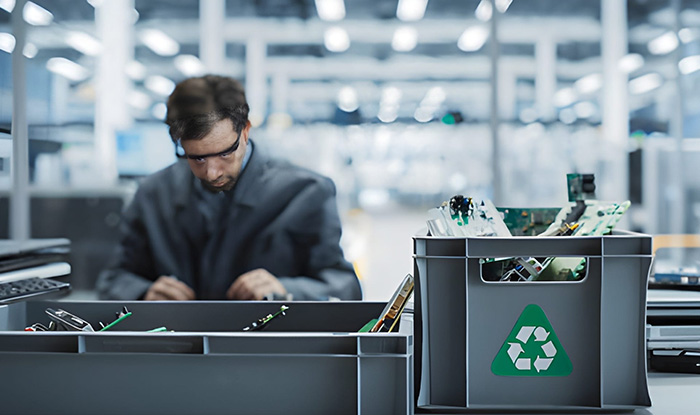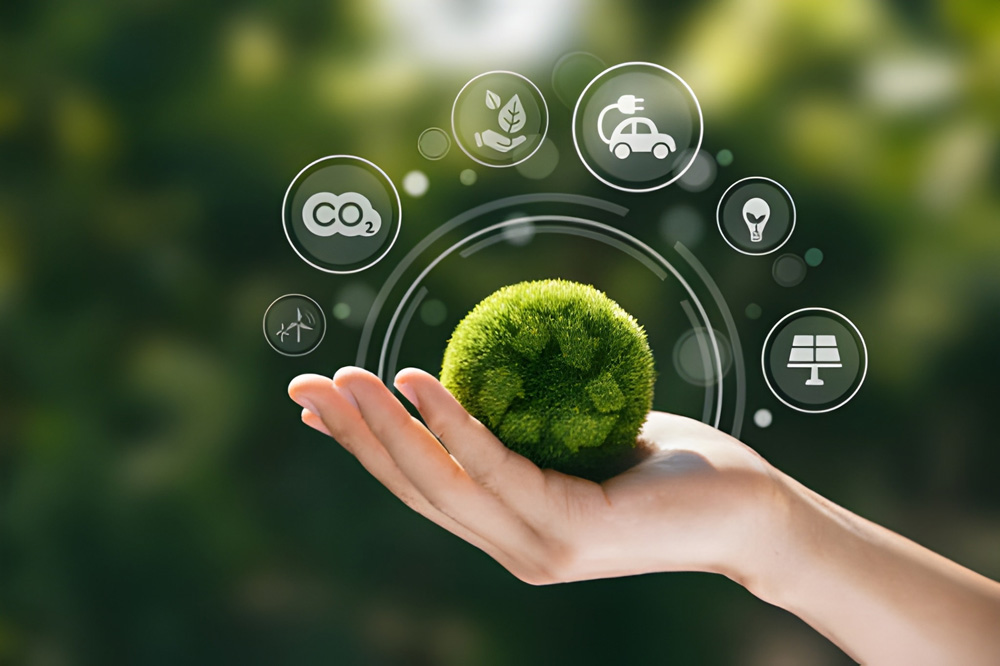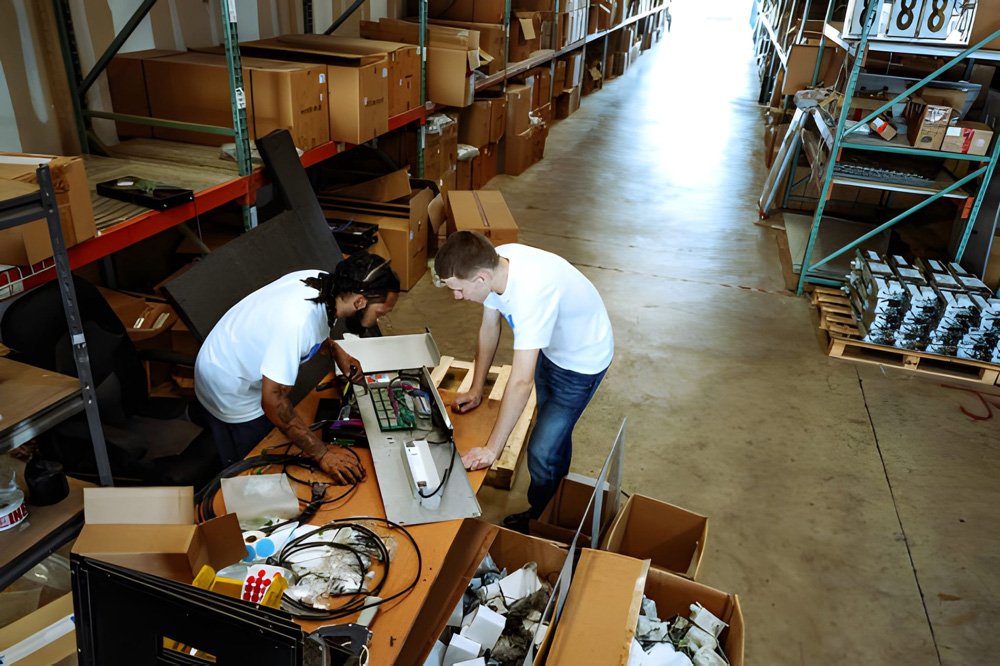Designing for a Second Life: The Rise of Repurposed Manufacturing

Photo Credit: iStockPhoto/gorodenkoff
For decades, manufacturing followed a simple rule: make, use, toss, repeat. It worked, until the planet started showing signs it couldn’t keep up. Mountains of waste, especially e-waste, now sit as reminders that our “out with the old, in with the new” mindset has an expiration date. That’s where the idea of designing for a second life comes in.
Instead of products ending up in landfills, designers and manufacturers are giving materials another shot at usefulness, such as by turning what was once waste into something valuable again. Think laptops reborn as lighting fixtures or old circuit boards reimagined as sleek jewellery. Here, creativity meets sustainability, and it’s changing how we think about production altogether.
Thankfully, repurposed materials aren’t another passing green trend; they’re quietly shaping the future of manufacturing. By designing with a second life in mind, they help cut costs, conserve resources, and spark innovation.
The Concept of Designing for a Second Life
Designing for a second life is about creating products that don’t end their journey in a landfill. It’s a mindset where every design stage, from sourcing to disposal, considers how materials can live on, either through reuse, repair, or transformation. Instead of focusing on short-term use, this approach builds long-term value and minimizes waste from its core.
How It Differs from Traditional Recycling
Recycling electronics usually reduces materials to their raw form, often reducing quality or usability in the process. Downcycling takes it a step further by reusing materials for lower-value products. Designing for a second life flips this model by preserving the integrity and value of materials. It focuses on repairability, modularity, and durability so components can be upgraded or replaced rather than discarded.
A Full Lifecycle Approach
Unlike traditional linear manufacturing, second-life design looks at the entire product lifecycle:
- Material sourcing: Using recycled, responsibly mined, or renewable materials.
- Design and manufacturing: Creating modular structures and standard parts for easy disassembly and repair.
- Post-use recovery: Developing systems for take-back, refurbishment, or repurposing before recycling.
This way, the product isn’t just made sustainably, it’s designed to stay useful.
Brands Leading the Way
Several forward-thinking companies are already putting this philosophy into practice:
- Fairphone builds smartphones with easily swappable parts like batteries and cameras. Their Fairphone 5 model uses 70% fair or recycled materials, and their collection program achieves a 63% device reuse rate.
- Dell integrates circular design into its laptops and desktops, using over 95 million pounds of recycled or renewable materials in 2024. They’ve also committed to reusing or recycling one product for every product sold by 2030.
Benefits of Designing for a Second Life
Designing electronics for a second life involves much more than extending a gadget’s lifespan. You need to dig deeper into how devices are made, used, and reintroduced into the system. When companies build products that are easy to repair, upgrade, or repurpose, it helps tackle one of the fastest-growing environmental issues: e-waste.

Image Source: iStock/Thx4Stock
1. Cuts Down on E-Waste Accumulation
The world produces over 62 million tonnes of e-waste every year, and only 22% of it is properly recycled (Global E-waste Monitor, 2024). Designing for a second life means fewer devices end up in landfills. Instead, components like batteries, chips, and screens are given new purposes in other devices or remanufactured systems..
2. Reduces Demand for New Raw Materials
Electronic components require rare minerals like cobalt, gold, and lithium. These resources are finite and environmentally costly to mine. When designers use reclaimed materials or modular parts, they lessen the need for fresh extraction.
3. Creates a Path for Smarter Product Design
When manufacturers consider a product’s second life from the start, design becomes more intentional. Gadgets are made modular, batteries are replaceable, and materials are labeled for easier sorting and reuse. This mindset encourages innovation, leading to better, more efficient tech that’s easier to maintain and recycle at the end of life.
4. Boosts Brand Trust and Market Appeal
Consumers are becoming more eco-conscious, especially in tech. A recent Deloitte report found that 64% of Gen Z consumers prefer to buy from brands with visible sustainability initiatives. Companies that design for circularity, like Apple, which recovers gold and rare earth elements through its “Daisy” recycling robot, gain credibility, loyalty, and long-term goodwill.
5. Supports a Circular Tech Economy
When devices are designed for disassembly or reuse, they fit naturally into a circular economy, where waste becomes input for new products. This not only reduces environmental harm but also opens up opportunities for secondary markets, repair businesses, and local refurbishing operations — creating jobs while conserving resources.
The Role of E-Waste in Modern Manufacturing
While e-waste has become the world’s fastest-growing waste stream, it has also turned into one of the most promising sources of raw material for modern industries. As manufacturers face rising material costs and sustainability pressures, the focus has shifted from mining the earth to mining what we’ve already used. Today, e-waste is a design and innovation opportunity that reshapes how products are made.
A Shift from Disposal to Design Thinking
Traditional manufacturing has long followed a linear model: extract, produce, consume, and discard. E-waste disrupts that flow by proving there’s still life left in “obsolete” materials. Modern manufacturing is beginning to view discarded electronics as design inputs rather than waste outputs.
Design teams are now thinking about how metals, plastics, and components can be extracted, repaired, or repurposed before a product is even made. This shift is changing how products are assembled, what materials are chosen, and how easily they can be taken apart at the end of life. In short, manufacturers are designing for reuse, not just use.
Building Supply Chains Around Reclaimed Materials
Supply chains are being restructured to accommodate recycled e-waste components. Instead of relying solely on virgin raw materials, companies are forming partnerships with e-waste processors and recovery facilities to secure a steady stream of usable resources.
These partnerships aren’t just about cost efficiency but about resilience. When global shortages of metals like lithium or copper disrupt production, reclaimed materials found in e-waste can fill the gap. By integrating e-waste into sourcing strategies, manufacturers gain a competitive edge, one that’s both economically and environmentally sustainable.
Innovation in Material Recovery Technologies
Advancements in recovery technologies are making e-waste a more viable manufacturing input than ever before. Modern hydrometallurgical and bioleaching techniques can now separate precious metals and rare elements with minimal environmental impact of e-waste.
Even small components like circuit boards and microchips are being processed more efficiently, allowing manufacturers to recover usable materials without significant loss of quality. This new wave of clean-tech recovery makes it possible for e-waste to re-enter production lines as high-quality material, not as a compromised substitute.
Integrating Circular Design into Production Models
Today, manufacturing revolves around producing things that last. E-waste recovery feeds into a broader circular design philosophy that values durability, reparability, and modularity.
Products designed with modular parts, standardized components, and easily separable materials extend their usable life and simplify end-of-life recovery. This design strategy reduces waste generation from the start and creates an ongoing loop where materials continuously cycle through production systems.
Challenges and Solutions in Scaling Repurposed Material Use
While the idea of turning e-waste into raw material sounds like a perfect circular solution, putting it into practice isn’t always straightforward. Scaling the use of repurposed materials comes with its own hurdles, from inconsistent supply to perception barriers. But as technology and policy evolve, the path forward is becoming clearer.

Image Source: iStock/Drazen_
Challenge: Inconsistent Supply and Material Quality
One of the biggest challenges in using repurposed materials is the unpredictability of supply. Unlike virgin resources that can be ordered in bulk, recycled materials, especially from e-waste, depend on what’s collected, recovered, and refined at any given time.
This inconsistency can make it difficult for manufacturers to maintain uniform production standards. Quality also varies: metals and plastics reclaimed from electronics may contain impurities or degrade through multiple processing cycles. Manufacturers must invest in advanced purification and testing systems to ensure that these recovered materials meet safety and performance requirements for industrial use.
Challenge: High Cost of System Redesign
Switching from traditional materials to reclaimed ones isn’t a simple swap. It often means rethinking entire production systems. Machines, molds, and manufacturing lines are typically designed for specific material grades and behaviors.
Reconfiguring them for new inputs, even if those inputs are recycled versions of the same materials, can be expensive and time-consuming. Smaller manufacturers, in particular, may struggle to justify the upfront costs, even if the long-term savings and sustainability benefits are clear. That’s why scalable design strategies and government incentives are critical to make circular production viable on a broader scale.
Challenge: The “Secondhand” Perception Problem
Another major barrier lies not in logistics but in perception. Many consumers still associate “recycled” or “repurposed” with “used,” “cheap,” or “inferior.” This stigma affects how brands communicate their sustainability efforts and price their products.
The truth is that modern repurposed materials can often outperform their virgin counterparts in strength, durability, and environmental impact. Many brands are helping shift this narrative by proving that circular products can also be sleek, high-performing, and desirable. But widespread change requires consistent messaging across industries, from packaging and electronics to fashion and automotive.
Now, let’s talk about how the industry is overcoming these barriers.
Solution: Technology as a Game-Changer

Image Source: iStock/vchal
Technology is rapidly closing many of these gaps. AI-powered sorting systems, for example, can now identify, classify, and separate materials from e-waste with remarkable precision—drastically improving recovery rates. Machine learning is also helping recyclers predict supply flows, optimize logistics, and maintain consistent material quality.
Robotics and automation are making disassembly safer and faster, while innovations in chemical recycling are turning even complex electronic components into reusable feedstock. These advancements make the dream of large-scale repurposing far more achievable and profitable.
Solution: Policy Support and Industry Collaboration
Government policies are increasingly stepping in to support the transition. Extended Producer Responsibility (EPR) programs, for instance, hold manufacturers accountable for their products’ end-of-life impact and encourage them to design with reuse in mind.
At the same time, public–private partnerships and industry coalitions are building shared recycling infrastructure, making access to repurposed materials more reliable. The EU’s Circular Economy Action Plan and similar initiatives in Japan and Canada are already driving investment in recovery systems and sustainable design education.
Solution: Redefining Resource Value
The future of repurposed manufacturing isn’t about eliminating every challenge — it’s about redefining how we value resources. As design innovation, policy reform, and technology converge, the barriers become opportunities.
Manufacturers that embrace circular design early won’t just gain sustainability credentials, they’ll build resilience, creative flexibility, and independence from volatile resource markets and set the tone for the next era of manufacturing.
The Future: Circular Design as the New Standard
Imagine a future where every product, from your laptop to your battery, is created with its next chapter already planned. That’s what circular design stands for: designing with longevity, repairability, and reusability built in from the start.
This shift transforms manufacturers from mere producers to stewards of their products’ full lifecycles. Instead of discarding old devices, companies reclaim, refurbish, and reintegrate materials back into production, keeping valuable resources in circulation.
The movement toward circular design isn’t only an environmental win. It’s a creative and economic one, too:
- Design innovation thrives when materials are given second lives, inspiring new aesthetics and smarter engineering.
- Resilient supply chains emerge as dependence on raw materials decreases.
- Brand trust and value grow as sustainability becomes central to a company’s identity.
Circular manufacturing is no longer a niche experiment; it’s the blueprint for the future. By treating e-waste as a strategic resource, industries are redefining what progress looks like in a world that designs for forever.
Summing Up
Designing for a second life isn’t just a sustainability buzzword. It’s a more innovative way to build the future. When manufacturers start seeing e-waste as a valuable resource instead of a burden, waste becomes opportunity. Repurposed materials are no longer a compromise; they’re redefining what quality, creativity, and innovation can look like in modern manufacturing.
The brands that design with longevity in mind — from the first sketch to the product’s next life — will lead the next industrial era.
At Hummingbird International, we can help make that shift possible by giving old tech a new purpose. Together with responsible laptop disposal and smart e-waste recovery, we’re powering the circular manufacturing revolution!
About The Author Kelly Sampson
Kelly Sampson is a writer, blogger, and environmental enthusiast. She has strong opinions about climate change, the dogs vs. cats debate, and Oxford commas. She has lent Hummingbird International her engaging and spirited voice and turned our blog into a great place to find valuable information about e-waste, e-waste recycling, and the ITAD industry. Explore our blog to read more of her work.






